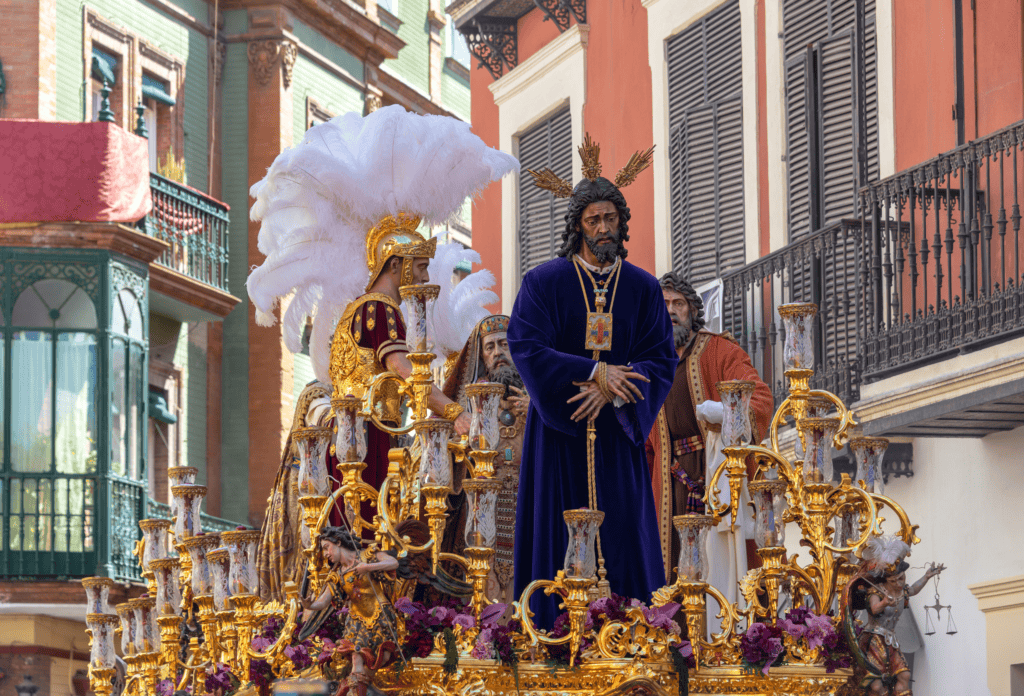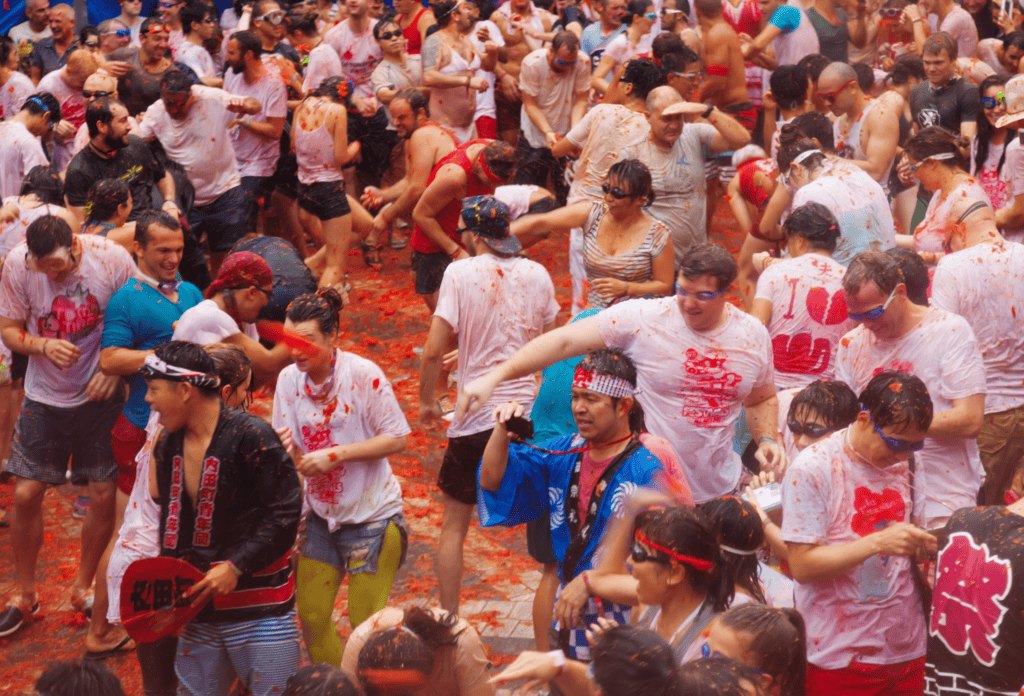In this post: Learn all about popular holidays celebrated in Spanish-speaking countries. Plus, find out more about our Spanish Holiday Bundle!
Culture and traditions shape language. In order to really learn a language and deeply understand it, we also need to understand the culture it comes from.

At Llamitas Spanish, we believe that learning Spanish means learning about Hispanic culture too.
This is why all of our curriculum levels are rooted in the traditions, culture, and history of Latin America and Spain.
Holidays are an excellent (and fun!) way to learn more about a culture. They tell you about a region’s history, religious beliefs, values, and so much more.
In this post, you’ll learn all about holidays celebrated in Spanish-speaking countries around the world!
Table of Contents
Llamitas Spanish Holiday Units
Before we delve into these important Hispanic holidays and traditions, don’t forget to take a look at our Llamitas Spanish Holiday Bundle.
While you can certainly plan your own Spanish holiday lessons, this digital course takes all of the hard work of lesson planning out of the equation.
It includes printable lessons for 7 different holidays throughout the year, including La Navidad, Dia de Muertos, El Mes de la Herencia Hispana, and more!
As a FREE bonus, you’ll also find four seasonal units included with this course, so you can keep learning all year long. Yay!

You’ll discover Spanish holidays and traditions through crafts, recipes, music, games, and even more fun activities with these done-for-you thematic Spanish lessons for kids.
If you’re looking for an easy way to celebrate hispanic culture holidays with your kiddos, you definitely want to check this out!
Related post: The Ultimate Spanish Gift Guide 2024
Major Spanish Speaking Holidays
So, what are some of the most important holidays in the Spanish-speaking world?
Between Latin America and Spain, there’s no shortage of yearly celebrations, so we’re highlighting some of the most popular for you right here.
Let the festividades begin!
Las Posadas
This religious Mexican holiday is celebrated from December 16–24 and commemorates the journey of Mary and Joseph from Nazareth to Bethlehem before the birth of Jesus. The festival is celebrated in Mexico and parts of the US.
During Las Posadas, a procession—which includes musicians, children dressed up as angels, and a manger scene or statues of Joseph and Mary—visits homes to ask for lodging, though they are always refused except for by one house.
The festivities also include scripture reading, Christmas carols, and traditional food!
Día de los Reyes Magos
Known as Three Kings Day or Epiphany in English-speaking countries, Día de los Reyes Magos is celebrated shortly after Christmas in Spain, Mexico, and across Latin America, on January 6.
This holiday is based on the biblical story of the Three Wise Men—also known as the Magi or the Three Kings—who brought gifts to baby Jesus, according to tradition.

Día de los Reyes Magos is celebrated a bit differently depending on the country, though many celebrations share similarities.
This often includes a parade, ring-shaped cake (representing the Three Kings’ crowns), and a tradition where children leave a shoe out for the kings and receive a gift in return.
Quinceañera
A quinceañera is a special celebration that happens on a girl’s 15th birthday in Mexico, Latin America, and other Latino communities across the US and Caribbean. It signifies the transition from girlhood to womanhood.
Traditionally, quinceañeras have included attending a mass service with close family, followed by a party with friends and family. Choreographed dancing, a cake cutting ceremony, and other symbolic activities are often a part of this celebration. However, this rite of passage continues to evolve and may be celebrated differently depending on the family.
In our Level 2 curriculum, you can read all about this tradition in the story, “Valera La Quinceañera.”

Día de Muertos
You’ve likely already heard of El Día de Los Muertos, since it’s one of the most well-known Mexican holidays. Taking place every year on November 2, this holiday is a time to honor loved ones who have passed on.
According to this tradition, the souls of deceased loved ones return to visit the living once a year.
Traditions of Día de Muertos include the ubiquitous calaveras (skulls), decorating with marigold flowers, and the ofrenda—an offering of items said to make the souls feel welcome. Parades, costumes, and of course food (such as pan de muerto) also play a big part in this celebration.

La Batalla de Puebla (Cinco de Mayo)
You may celebrate Cinco de Mayo with delicious food every year, but do you know the history behind it?
Also known in Mexico as La Batalla de Puebla, this holiday celebrates Mexico’s victory over French forces during the Battle of Puebla on May 5, 1862.
Every year on May 5, the state of Puebla, Mexico holds a large celebration that includes speeches, parades, and a reenactment of the battle.
Although the rest of the country doesn’t typically commemorate La Batalla de Puebla, Cinco de Mayo has become popular in the US as a celebration of Mexican heritage.
Semana Santa
In the week leading up to Easter Sunday, the Christian religious tradition called Semana Santa (or Holy Week) is celebrated throughout Spain and Latin America.
This holiday week is a celebration of the Passion of Christ, or the final period of Jesus’ life before the crucifixion.
In Spain, a major part of Semana Santa are the processions carried out night and day throughout the week.
Thousands will watch these parades as large floats of religious statues and flowers carried by church members pass by, followed by nazarenos dressed in dark robes and carrying crosses or candles.
Although it’s a celebration, this holiday can also be quite sombre and moving as participants reflect on the crucifixion.

New Year’s Day
New Year’s Day is celebrated throughout the world, which means you’ll find many different traditions for this holiday across Spain and Latin America.
Just like in other parts of the world, many of the festivities take place on December 31—New Year’s Eve (or la Nochevieja)!
One of the most well-known New Year’s traditions in Spanish-speaking countries is eating 12 grapes at midnight for good luck in the upcoming year.
In Ecuador and Panama, lighting muñecos, essentially large rag dolls, symbolizes saying goodbye to the past year. Cleaning the house, packing a suitcase, or lighting colorful candles are other popular ways to celebrate.

Related post: Hispanic New Year’s Eve Traditions
Fiesta de la Candelaria (Candlemas)
This holiday is celebrated 40 days after Christmas, on February 2. It commemorates baby Jesus being presented at the temple by Mary and Joseph, according to Catholic tradition.
While perhaps the most popular celebration takes place in the city of Puno in South Peru, this holiday is observed across Latin America and Spain.
Fiesta de la Candelaria festivities vary by region, often blending religious traditions with the local culture. A typical Candlemas celebration in any country might include a procession, music, dancing, folklore, and food.
The celebration in Peru is massive, showcasing the diverse cultures of the area with elaborate costumes, choreographed dances, and much more!

Día de la Independencia
Mexico’s independence day, or Día de la Independencia, is celebrated on September 16. This important Mexican holiday commemorates the day when Mexico began to fight for their independence from Spain in 1810. However, Mexico wouldn’t gain complete independence for more than ten years, in 1821.
Festivities begin on September 15 in Mexico City, with a reenactment of the “Grito de Independencia” or “Independence Battle Cry,” which marked the beginning of the movement.
The celebration also includes plenty of music, food, fireworks, and the colors of Mexico’s flag—red, white, and green.

Día de la Raza
Called “Race Day” in English, this holiday is celebrated on October 12 as a time to recognize Latin America’s cultural diversity as a country of both indigenous and European heritage.
Much like Indigenous Peoples Day in the US, this holiday can be seen as an alternative to celebrating the controversial Columbus Day.
The holiday is observed throughout many Spanish-speaking countries and includes parades, food, dance, and more in celebration of Latino and Hispanic culture.
Pan American Day
Also celebrated on October 12 in the country of Belize is Pan American Day. Like Día de la Raza, this day celebrates the country’s cultural diversity rather than Christopher Columbus.
The culture of Belize is the result of various indigenous groups who migrated to the area, and this holiday is seen as a time to appreciate its vibrant, multicultural identity.
Carnaval
Carnaval, sometimes called Carnival, is a colorful, week-long Spanish festival that usually takes place toward the end of February, marking the beginning of Lent.
This holiday has both Catholic and pagan origins and is known for the elaborate costumes, floats, parades, concerts, and parties you can find all across Spain during this time.
Las Fallas de Valencia
The Fallas festival in Valencia, Spain celebrates the arrival of Spring. While the festivities can begin as early as March 1, the main festival days are March 15–19.
This festival is known for its monuments made from wood called fallas, which are burned as part of the celebration. It’s amazing to see the beautiful monuments that have been built knowing they will soon be destroyed by flames. There are also parades, music, fireworks, and of course food!

Día de la Constitución
Constitution Day is celebrated in Mexico on the first Monday in February each year. It’s a public holiday celebrating the creation of Mexico’s constitution on February 5, 1917.
The constitution is seen as a victory of the Mexican Revolution. It established important rights and social equity for the people of Mexico.
Las Fiestas Agostinas
Throughout August, a series of festivals are celebrated in El Salvador, known as Las Fiestas Agostinas.
One such festival is La Fiesta de San Salvador on August 6, celebrating the Transfiguration of Jesus Christ, who is the city’s patron saint.
While religious in origin, the festivals are also a celebration of El Salvador’s culture—with plenty of music, dancing, traditional food, and more to enjoy.
La Tomatina
Described as the largest food fight in the world, at La Tomatina festival in Buñol, Spain, participants throw tomatoes at each other. Yup, you read that right!
This festival takes place on the last Wednesday in August. It has become so popular with tourists, it has become a ticketed event, limited to 20,000 participants.

The messy celebration begins when a ham is attached to a large pole and lifted into the air as participants attempt to pull it down.
This is followed by literal truckloads of tomatoes being unloaded for the food fight—and this is when the chaos ensues.
Homeschool Spanish Curriculum Levels
Learning a new language means learning a new culture—the two are inseparable. This is why our Llamitas Spanish Curriculum series is rooted in Hispanic culture.

With curriculum levels for preschool through elementary grades, we provide you with everything you need to raise bilingual and biliterate children.
If you’re looking for a robust, open & go Spanish curriculum for kids, look no further!
